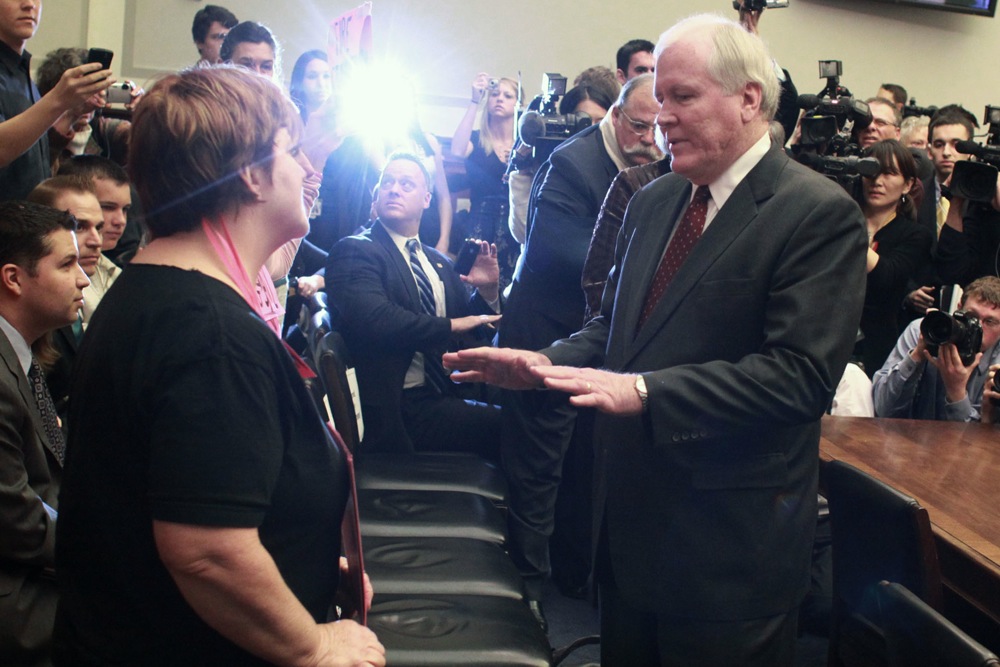White House, Congress Complicit in AIG Bonus Scandal
After Congress released the second $350 billion in TARP funding, President Obama made sure new rules wouldn’t be so strict that they would scare away the employees of recipient companies.
Jul 31, 2020126.7K Shares2.6M Views
AIG CEO Edward Liddy pleads for civility with a sometimes hostile crowd at Wednesday's congressional hearing. (WDCpix)
On day four of AIG bonus-gate, the message from Capitol Hill has emergedas clear as it is unanimous: The $165 million paid this week to executives of bailed-out American International Group is “appalling,” “outrageous” and “a breach of public trust.”
Illustration by: Matt Mahurin
Yet as pitchfork populism continues to fuel the congressional castigation, a vital element of the debate has gone largely ignored: Congress, going back to September, has had numerous opportunities to limit executive pay for bailed-out banks, only to ignore or abandon those efforts in the face of opposition from the finance industry, the White House or both.
The result has been that hundreds of billions of dollars in bailout funds have left Washington with virtually no conditions on how the money would be spent. The banks have taken advantage of that freedom, collectively paying out billions in bonuses, retention salaries and other perks to the same employees who helped run the companies into the ground.
Julian E. Zelizer, congressional expert at Princeton University, said the failure of policymakers to limit executive pay for bailed out banks was no accident. “Neither Congress nor the president wanted to look as if they were ‘taking over’ financial institutions,” Zelizer wrote in an email, “nor did they want to anger business.”
The result, he added, was “predictable:” a bailout strategy with plenty of leeway for the companies receiving the money.
Indeed, allowing most bonus payments to continue was a central element of both the Bush and Obama administrations’ bailout strategies. When Henry Paulson, Treasury secretary under the Bush White House, first unveiled the Troubled Asset Relief Program in September, the public wailed about the absence of conditions on the money. Congress intervened to add some limits on executive pay — provisions that Senate Banking Committee Chairman Christopher Dodd (D-Conn.) labeled “anything but mild.” But liberal critics of those compensation limits, including a number of congressional Democrats, pointed out loopholesallowing the companies to pay their executives virtually any sum they wanted. Most provisions, for example, apply only to companies receiving more than $300 million in TARP funds.
“Under this bill,” Sen. Bernie Sanders (I-Vt.) said at the time, “the CEOs and the Wall Street insiders will still, with a little bit of imagination, continue to make out like bandits.”
In January, the House passed legislationplacing tighter restrictions on TARP spending, including tougher limits on executive pay. Senate Democrats, pressed by administration officials, never took up the bill.
A month later, after Congress released the second $350 billion in TARP funding, President Barack Obama tightened the restrictions on executive pay, but not without including a telling caveat: The rules wouldn’t be so strict that they would scare away the employees of recipient companies.
“The Treasury guidelines on executive pay,” according to a department press release, “seek to strike the correct balance between the need for strict monitoring and accountability on executive pay and the need for financial institutions to fully function and attract the talent pool that will maximize the chances of financial recovery.”
Indeed, the guidelines — which fleetingly raised hopes among government watchdog groups that the new administration would break sharply from the past over executive pay — were full of loopholes. A $500,000 pay cap, for example, applies only to “senior executives,” and only the companies accepting “exceptional assistance” under TARP are subject to it. In another controversial provision, the restrictions don’t apply to those companies receiving TARP funds before the new rules were announced.
More recently, some Senate lawmakers tried to attach executive pay limits to the $787 billion stimulus bill, passed in the middle of February. One amendment, sponsored by Sen. Claire McCaskill (D-Mo.), would have capped executive compensation at $400,000 a year. Another, sponsored by Sens. Ron Wyden (D-Ore.) and Olympia Snowe (R-Maine), would have forced TARP recipients to reimburse the government for any 2008 bonuses in excess of $100,000 or pay a 35 percent tax. Both amendments were stripped from the stimulus bill during negotiations with House lawmakers and White House officials.
One executive compensation amendment survived the stimulus negotiations. Sponsored by Dodd, the provision prohibits bonuses for a set number of executives based on the amount of federal help the companies receive. For companies accepting less than $25 million, the bonus-ban would apply only to the chief executive. For those receiving more than $500 million, the prohibition would expand to the 25 top employees. But the law doesn’t apply to the AIG bonuses. That’s because, during negotiations after the Senate bill passed, Treasury officials insisted on an exemption for contractually obligated bonuses, like those recently paid by AIG.
There are other absurdities surrounding the recent AIG-bonus outcry. Not least of all, AIG’s bonuses have been well knownas far back as December, when stories emerged that the insurance giant — which had received $152 billion in federal help at the time — would pay hundreds of employees bonuses as high as $4 million.
David Arkush, director of Public Citizen’s Congress Watch, said that the delayed reaction is a signal that voters have had enough. “This is sort of like a perfect storm,” Arkush said. “The [AIG] bonuses send a strong signal to the public that these firms are acting wildly, they’re acting irresponsibly, and Washington has done nothing to rein them in.”
The outcry over the AIG bonuses — exacerbated by yesterday’s headlines that 73 AIG executives received bonuses exceeding $1 million — could have much further reaching effects. Rep. Paul Kanjorski (D-Penn.), chairman of the Capital Markets subcommittee, said during a panel hearing Wednesday that the episode might jeopardize future bailout legislation that many lawmakers and finance experts maintain will be necessary to rescue the flailing economy. Appearing before the panel, AIG CEO Edward Liddy defended the bonuses with the argument that the company’s most talented employees would seek greener pastures if the bonuses are withheld.
“We have to continue managing our business as a business,” Liddy said.
Lawyers for the company have also claimed that, fair or unfair, they’re contractually obligated to make good on the controversail bonus payments.
That argument doesn’t fly among some experts, however. Peter Morici, economist at the University of Maryland, said this week that, if the Treasury forced the autoworkers to change their contracts as a condition of the automaker bailout, it could do the same for the banks.
“The federal government imposed the renegotiation of the labor contracts at General Motors and Chrysler, and it could have imposed it at AIG,” Morici said yesterday in an interview with National Public Radio. “It was employment contracts in both places. You know, it’s up to [Treasury] Secretary [Tim] Geithner to defend his conduct.”
The saga has led a number of powerful lawmakers to propose legislation this week forcing AIG to repay the $165 million. One such proposal would empower the U.S. attorney general to recover the money. Others would tax the bonuses at sky-high rates to get the cash back. House Speaker Nancy Pelosi (D-Calif.) said she wants “closure” on a bill by next week.
But Charles M. Elson, an executive compensation expert at the University of Delaware, said that there’s little lawmakers can do. “The contract was between the company and the individual,” Elson said. “How [is] the Congress going to get the money back?”
Amid a struggling economy, Elson added, lawmakers are simply pandering in the face of the public outcry. “The bonuses are horrible,” Elson said. “But at this point, they’re almost, unfortunately, water under the bridge.”

Paula M. Graham
Reviewer
Latest Articles
Popular Articles

